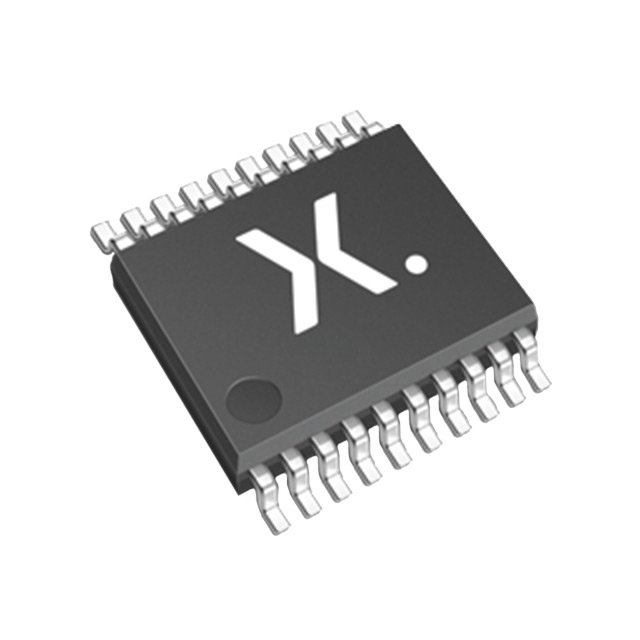Lihat spesifikasi untuk detail produk.

Encyclopedia Entry: 74HC240PW,118
Product Overview
Category
The 74HC240PW,118 belongs to the category of integrated circuits (ICs), specifically a type of logic gate.
Use
This product is commonly used in digital electronics for signal processing and data manipulation. It serves as an octal buffer/line driver with 3-state outputs.
Characteristics
- Octal buffer/line driver
- 3-state outputs
- High-speed CMOS technology
- Low power consumption
- Wide operating voltage range
- Schmitt-trigger action on all inputs
- Balanced propagation delays
Package
The 74HC240PW,118 is available in a small outline package (SOT360-1) with 20 pins.
Essence
The essence of this product lies in its ability to provide buffering and line driving functions for digital signals, ensuring reliable transmission and compatibility between different components.
Packaging/Quantity
The 74HC240PW,118 is typically packaged in reels or tubes, with a quantity of 2500 units per reel or 75 units per tube.
Specifications
- Supply voltage: 2 V to 6 V
- Input voltage: 0 V to VCC
- Output voltage: 0 V to VCC
- Operating temperature range: -40°C to +125°C
- Input capacitance: 3.5 pF
- Output capacitance: 6 pF
- Input leakage current: ±1 μA
- Output current: ±6 mA
Detailed Pin Configuration
The 74HC240PW,118 has a total of 20 pins, which are assigned specific functions as follows:
- GND: Ground
- A1: Input A1
- A2: Input A2
- A3: Input A3
- A4: Input A4
- A5: Input A5
- A6: Input A6
- A7: Input A7
- A8: Input A8
- OE: Output Enable
- Y1: Output Y1
- Y2: Output Y2
- Y3: Output Y3
- Y4: Output Y4
- Y5: Output Y5
- Y6: Output Y6
- Y7: Output Y7
- Y8: Output Y8
- VCC: Supply voltage
- GND: Ground
Functional Features
The 74HC240PW,118 offers the following functional features:
- Octal buffer/line driver with 3-state outputs
- High-speed operation suitable for various digital applications
- Schmitt-trigger action on all inputs for improved noise immunity
- Balanced propagation delays ensure synchronized signal transmission
- Low power consumption makes it energy-efficient
Advantages and Disadvantages
Advantages
- Provides reliable buffering and line driving functions
- Wide operating voltage range allows compatibility with different systems
- High-speed CMOS technology enables fast data processing
- Schmitt-trigger action enhances noise immunity
- Low power consumption reduces energy usage
Disadvantages
- Limited output current capacity may restrict use in certain applications
- Sensitive to electrostatic discharge (ESD), requiring proper handling and precautions
Working Principles
The 74HC240PW,118 operates by receiving input signals on its eight input pins (A1-A8) and generating corresponding output signals on the eight output pins (Y1-Y8). The Output Enable (OE) pin controls the activation of the outputs. When OE is low, the outputs are enabled and reflect the input signals. Conversely, when OE is high, the outputs are in a high-impedance state, effectively disconnecting them from the circuit.
Detailed Application Field Plans
The 74HC240PW,118 finds applications in various digital systems, including but not limited to:
- Microcontrollers and microprocessors
- Data communication systems
- Memory interfacing
- Address decoding
- Bus driving and buffering
- Signal level shifting
- General-purpose logic-level conversion
Detailed and Complete Alternative Models
There are several alternative models available that offer similar functionality to the 74HC240PW,118. Some notable alternatives include:
- SN74HC240N by Texas Instruments
- CD74HC240E by Texas Instruments
- MC74HC240AN by ON Semiconductor
- 74HCT240 by NXP Semiconductors
These alternatives can be considered based on specific requirements, availability, and compatibility with the target system.
In conclusion, the 74HC240PW,118 is a versatile octal buffer/line driver integrated circuit widely used in digital electronics. Its high-speed operation, low power consumption, and reliable signal processing capabilities
Sebutkan 10 pertanyaan dan jawaban umum terkait penerapan 74HC240PW,118 dalam solusi teknis
Sure! Here are 10 common questions and answers related to the application of 74HC240PW,118 in technical solutions:
Q: What is the 74HC240PW,118? A: The 74HC240PW,118 is a high-speed octal buffer/line driver with 3-state outputs, commonly used in digital logic circuits.
Q: What is the maximum operating voltage for the 74HC240PW,118? A: The maximum operating voltage for the 74HC240PW,118 is typically 5.5V.
Q: How many inputs and outputs does the 74HC240PW,118 have? A: The 74HC240PW,118 has 8 inputs and 8 outputs.
Q: Can the 74HC240PW,118 be used as a level shifter? A: Yes, the 74HC240PW,118 can be used as a level shifter to convert signals between different voltage levels.
Q: What is the maximum output current that the 74HC240PW,118 can drive? A: The 74HC240PW,118 can typically drive up to 35mA of output current per channel.
Q: Is the 74HC240PW,118 compatible with both TTL and CMOS logic levels? A: Yes, the 74HC240PW,118 is compatible with both TTL and CMOS logic levels.
Q: Can the 74HC240PW,118 be used in bidirectional data transfer applications? A: No, the 74HC240PW,118 is a unidirectional buffer and cannot be used for bidirectional data transfer.
Q: Does the 74HC240PW,118 have built-in protection against overvoltage or ESD events? A: No, the 74HC240PW,118 does not have built-in protection against overvoltage or ESD events. External protection measures may be required.
Q: What is the typical propagation delay of the 74HC240PW,118? A: The typical propagation delay of the 74HC240PW,118 is around 10-15 nanoseconds.
Q: Can the 74HC240PW,118 be used in high-frequency applications? A: Yes, the 74HC240PW,118 can be used in high-frequency applications, but its performance may be limited compared to specialized high-speed buffers.
Please note that these answers are general and may vary depending on specific datasheet specifications and application requirements.

